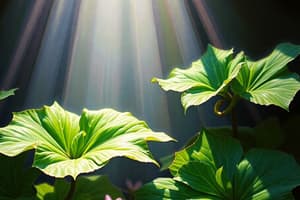Podcast
Questions and Answers
Where does photosynthesis primarily occur in plants?
Where does photosynthesis primarily occur in plants?
- Leaves (correct)
- Roots
- Stem
- Flowers
What is the role of chlorophyll in photosynthesis?
What is the role of chlorophyll in photosynthesis?
- Releasing carbon dioxide
- Trapping sunlight energy (correct)
- Absorbing water
- Producing oxygen
What is the main source of nutrition for plants?
What is the main source of nutrition for plants?
- Water
- Oxygen
- Carbon dioxide
- Glucose (correct)
What gas do plants release as a byproduct of photosynthesis?
What gas do plants release as a byproduct of photosynthesis?
Which tissue transports water from roots to leaves in plants?
Which tissue transports water from roots to leaves in plants?
Flashcards are hidden until you start studying
Study Notes
- Plants make their own food through photosynthesis, where they use sunlight to produce glucose, their main source of nutrition for growth and function.
- Roots of plants absorb water from the soil, which travels through xylem tissue to the leaves, while leaves take in carbon dioxide from the air through stomata.
- Photosynthesis occurs in cells like Palisade and spongy cells in the leaves, which contain chloroplasts with chlorophyll, the green pigment that traps sunlight energy for chemical energy.
- Chlorophyll splits water molecules into hydrogen and oxygen atoms, using the chemical energy to create glucose from hydrogen and carbon dioxide, providing food for the plant's growth.
- Plants release oxygen as a byproduct of photosynthesis, which is essential for humans as we inhale oxygen and exhale carbon dioxide, showing the important partnership between plants and humans.
Studying That Suits You
Use AI to generate personalized quizzes and flashcards to suit your learning preferences.



